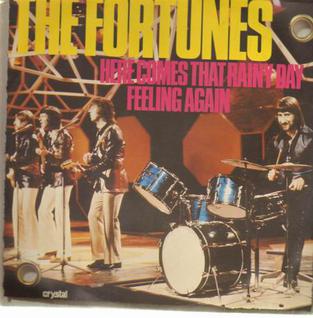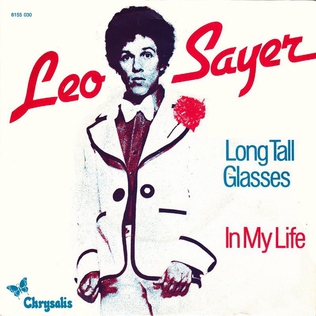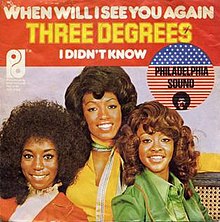
"Thank God I'm a Country Boy", also known as "Country Boy", is a song written by John Martin Sommers and recorded by American singer/songwriter John Denver. The song was originally included on Denver's 1974 album Back Home Again. A version recorded live on August 26, 1974, at the Universal Amphitheatre in Los Angeles was included on his 1975 album An Evening with John Denver. The live version was released as a single and went to No. 1 on both the Billboard magazine Hot Country Singles and Billboard Hot 100 charts. The song topped both charts for one week each, first the country chart, and the Hot 100 chart a week later. Thank God I'm a Country Boy also became the name of a variety special show hosted by Denver in 1977.

"TSOP (The Sound of Philadelphia)" is a 1974 recording by MFSB featuring vocals by The Three Degrees. It was written by Gamble and Huff as the theme for the American musical television program Soul Train, which specialized in African American musical performers. The single was released on the Philadelphia International Records label. It was the first television theme song to reach No. 1 on the Billboard Hot 100.

"The Air That I Breathe" is a ballad written by the British-Gibraltarian singer-songwriter Albert Hammond and the English songwriter Mike Hazlewood. It was initially recorded by Hammond on his debut album, It Never Rains in Southern California (1972). After being covered by Phil Everly in 1973, it was a major hit for the Hollies in early 1974, reaching number two in the UK Singles Chart. It was the Hollies' last major hit. The English rock band Radiohead reused the chord progression and melody of "The Air That I Breathe" for their 1992 song "Creep".

"Chevy Van" is a song by American singer and songwriter Sammy Johns, written and sung by Johns. The song was originally released in 1973 by GRC Records on Johns debut album, which was also released in 1973. The instrumental backing was played by Los Angeles-based session musicians from the Wrecking Crew.

"Until You Come Back to Me (That's What I'm Gonna Do)" is a song written by Morris Broadnax, Clarence Paul, and Stevie Wonder. The song was originally recorded by Stevie Wonder in 1967, but his version was not released as a single and did not appear on an album until 1977's anthology Looking Back. The best-known version of this song is the 1973 release by Aretha Franklin, who had a million-selling top 10 hit on Billboard charts. The song reached No. 1 on the R&B chart and No. 3 on the Hot 100 chart in 1974. It became an RIAA Gold record.

"Sideshow" is a song recorded by American R&B soul vocal quintet Blue Magic, released in 1974. It was first released on the album Blue Magic and when issued as a single it sold over a million copies, going to No.1 R&B in April 1974 and No.8 pop in the United States in that summer. Billboard ranked it as the No.19 song for 1974. In the Canadian Year-end chart, it was No.77.

"The Most Beautiful Girl" is a song recorded by Charlie Rich and written by Billy Sherrill, Norro Wilson, and Rory Bourke. The countrypolitan ballad reached No. 1 in the United States in 1973 on three Billboard music charts: the pop chart, the country chart, and the adult contemporary chart, as well as in Canada on three RPM charts: the RPM 100 Top Singles chart, the Country Tracks chart, and the Adult Contemporary chart. Billboard ranked it as the No. 23 song for 1974.

"You're the Best Thing That Ever Happened To Me" — also known simply as "Best Thing That Ever Happened To Me" — is a song written by Jim Weatherly, and produced by Don Law. It was first recorded in 1973 by Danny Thomas. Soon after it was done by Ray Price from his album You're the Best Thing That Ever Happened To Me. The song enjoyed two runs of popularity, each by an artist in a different genre.

"Take Me in Your Arms (Rock Me a Little While)" is a song written by the premier Motown songwriting/production team of the 1960s Holland–Dozier–Holland. The first hit recording was sung by Kim Weston in 1965. It was most popular in 1975 when it was recorded by the Doobie Brothers.

"Fire" is a song by R&B/funk band Ohio Players. The song was the opening track from the album of the same name and hit No. 1 on both the Billboard Hot 100 and the Hot Soul Singles chart in early 1975. It spent two weeks atop the soul chart. "Fire" was the Ohio Players' only entry on the new disco/dance chart, where it peaked at No. 10. The song is considered to be the band's signature song along with "Love Rollercoaster".

"Feel Like Makin' Love" is a song composed by singer-songwriter and producer Eugene McDaniels, and recorded originally by soul singer-songwriter Roberta Flack. The song has been covered by R&B and jazz artists including D’Angelo, Roy Ayers, Gladys Knight & the Pips, Lou Rawls, Isaac Hays, George Benson, Jeffrey Osborne, Larry Coryell, Johnny Mathis, and Marlena Shaw.

"Do It ('Til You're Satisfied)" is a popular song by funk group B. T. Express, written by songwriter Billy Nichols.

"I'm Leaving It Up to You" is a song written by and originally performed by Don Harris and Dewey Terry in 1957. It was later popularized in 1963 by the American duo Dale and Grace, who took it to #1 on the Billboard Hot 100 chart. In 1974, Donny and Marie Osmond reached the top five on the US Hot 100 chart and peaked at #1 on the Billboard Hot Adult Contemporary chart with their cover.

"Hi-Jack" is a 1974 r&b and funk disco based song written by Spanish musician Fernando Arbex and originally recorded by his group Barrabás for their album ¡Soltad a Barrabás!. While their version of the song was a huge success in their native Spain, going all the way to Number one over there, the song flopped in America, stalling at just number No. 104 on the Bubbling Under the Billboard Hot 100 Charts in July 1975. It was later a hit single for jazz flautist Herbie Mann.

"Third Rate Romance" is a song written by Russell Smith, first recorded in Montreal in 1974 by Jesse Winchester and his band the Rhythm Aces, assisted by Smith. It became a hit the following year by the newly re-formed Amazing Rhythm Aces on its 1975 album Stacked Deck. It was the band's debut single, reaching No.11 on the U.S. country singles chart and No.14 on the Billboard Hot 100, as well as No.1 on the Canadian RPM Country Tracks and Top Singles charts.

"Hang On in There Baby" is a song written by American musician Johnny Bristol and arranged by H. B. Barnum as the title track from his first album. It was released as a single in 1974, reaching No. 8 on the U.S. Hot 100 and No. 2 on the U.S. R&B chart. In the UK it reached No. 3.

When Will I See You Again is an album by American pop singer Johnny Mathis that was released in March 1975 by Columbia Records and was again predominantly composed of covers of recent hit songs by other artists.

"You Turn Me On, I'm a Radio" is a song written and originally recorded by Canadian singer songwriter Joni Mitchell. It was released on her fifth studio album entitled For the Roses and was issued as a single as well.

"Here Comes That Rainy Day Feeling Again" is the title of a pop song composed by Tony Macaulay, Roger Cook, and Roger Greenaway; it became the third U.S. Top 40 hit for The Fortunes in 1971, and their fifth in Canada.

"Long Tall Glasses (I Can Dance)" is a 1974 song by Leo Sayer, co-written with David Courtney. It was released in the United Kingdom in late 1974, becoming Sayer's third hit record on both the British and Irish singles charts and reaching number four in both nations. It was included on Sayer's album Just a Boy.



















